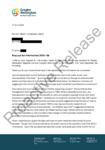Response to LGOIMA request 2025 166 17 June 2025
Search in document library
This LGOIMA is a follow up to a previous LGOIMA request 2025-125 16 May 2025 that has been proactively released and can be found here
Requested information:
"Thank you for your recent email reply it was appreciated but still leaves me unresolved.
"ground-based pest control methods are not practical due to the scale, terrain, and inaccessibility of the area." "ground-based control is carried out through an extensive bait station and trap network in the Wainuiomata Mainland Island." do these two coments not suggest ground control is possible over the larger area if tendered to professional contractors?
Why cherry pick such sentence without further supporting context? " Environmental Risk Management Authority's 2007 reassessment of 1080. While it identified some risks, the reassessment concluded that the benefits to native ecosystems outweigh those risks when the poison is applied responsibly." I actually do not recall this comment from that 2007 report. Within the 2007 report the excetutives summary actually suggested along the lines of "due no
current economic alternative to aerial 1080 its use may continue but research and developments should be actively explored." Jan Wrights report 2011 suggested something more similar to that you have stated. Jan Wright had also been introduced to an alternative, automated baitstations, that provides a step change in both landscape implementation economic's and ecological achievement.
When I observed your graph the highs and lows for each treatment have similar 6 points between. Though I am more concerned by the eradic nature of the operation zone from 2013 / 14 onwards. I ask if the two observed treatment zones were aside each other (within km's or each other) and were they of similar landscape scale? Had the "control" area ever been aerial 1080 managed?
Please advise the years when aerial 1080 was applied in relation to the graph supplied. Also please advise if the toxin used within the fore mentioned baitstations was a chain poison (2nd generation)
I observed the bird monitor data, was that formed from a single species or multiple species. Do you have comparing graphs that display individual monitored bird species along a similar timeline?
I note your team have provided a thoughtful management plan. It displays an extensive effort with the reporting and management of the area. One statement suggested rats returned to pre control densities within 12 months then further within the document it suggests 18 mths.
Within the trapped and baitstation area do the pest numbers also increase due reinvasion or internal breeding success?
The ecological report identifies crayfish as being present but fails to further discuss them, I wonder if any crayfish monitoring concludes existence of juveniles, that existing poplutations continue to successfully breed replacements in the implementation zone where aerial 1080 has been used? Within the areas I work within Puketi Forest crayfish appear absent now, 33 years after the last aerial 1080. Crayfish are suspected to live less than 30 years.I note warrior traps are being used. We also worked alongside DOC monthly serviced warrior kill traps and dispalyed a 425% increased capture per weekly visit and 625% capture increase per monthly return using EM100 with cyanide in 2016.
How many hectares is the Mainland Island complete with its buffer?
Lastly it was noted 5% RTC was 22% WTI. I ask why when monitored by DOC 5% RTC equals 35% wax tag
Lastly I was of the understand that any person "knowing killing native species" requires an exemption from the Minister of Conservation to remain within legally permitted parameters. To suggest aerial 1080 doesn't require such exemption is incorrect as even DOC / Ospri operations appear to require an exemption signed off.
I was encouraged that your operations team showed an interest in enviroMate100 technology in 2019 but fully realise EM100 is a specialist tool designed for use by professionally trained "output" pest control contractors with CSL. This enabling the most from the technology targeting possums rats and other pest species through strategy."
